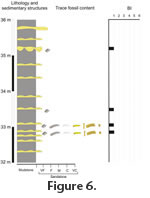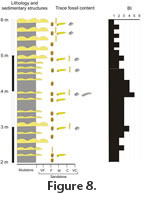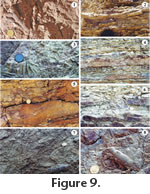| |
UPPER-OFFSHORE ICHNOFABRICS IN THE
LOWER PALEOZOIC NORTHWEST ARGENTINA BASIN
As is the case of most storm-influenced offshore deposits (e.g.,
Pemberton and Frey 1984;
Pemberton and MacEachern 1997), two trace-fossil suites (fairweather and storm-related) characterize these upper-offshore deposits. The fairweather suite reflects the activity of the benthic community developed under stable and rather predictable conditions. This suite records the activity of populations displaying K-selected or climax strategies. The storm-related suite indicates colonization after the storm event. This second trace-fossil suite is produced by an opportunistic community displaying r-selected population strategies in an unstable environment characterized by stressful conditions. The storm-related suite in the upper-offshore deposits studied consists of vertical structures, such as Skolithos, Arenicolites, and rarely Diplocraterion, produced by suspension feeders and preserved as endichnial structures in sandstone tempestites.
 Escape structures are dominant in some thin silty fine-grained sandstone tempestites.
The storm-related suite does not display significant changes in ichnotaxonomic composition, density of burrows and penetration depth through the Cambrian-Ordovician, and seems to be less sensitive to evolutionary events (Mángano and Buatois 2003). Accordingly, we focus our discussion on the ichnofabric produced by the fairweather fauna. Escape structures are dominant in some thin silty fine-grained sandstone tempestites.
The storm-related suite does not display significant changes in ichnotaxonomic composition, density of burrows and penetration depth through the Cambrian-Ordovician, and seems to be less sensitive to evolutionary events (Mángano and Buatois 2003). Accordingly, we focus our discussion on the ichnofabric produced by the fairweather fauna.
Furongian to Lower Tremadocian Ichnofabrics
These ichnofabrics are present in the Lampazar Formation; the Casa Colorada Member of the Santa Rosita Formation, and the Alfarcito Member of the Santa Rosita Formation (Figure 5,
Figure 6).
 Furongian to lower Tremadocian upper-offshore ichnofabrics resulting from the activities of the resident fauna are dominated by epifaunal to shallow-tier structures. Therefore, bioturbation index of the fairweather deposits is typically 0-1, with trace fossils commonly emplaced and observed parallel to bedding-plane. Accordingly, little disturbance of the primary fabric is present (Figure 4.1-4.3). Furongian to lower Tremadocian upper-offshore ichnofabrics resulting from the activities of the resident fauna are dominated by epifaunal to shallow-tier structures. Therefore, bioturbation index of the fairweather deposits is typically 0-1, with trace fossils commonly emplaced and observed parallel to bedding-plane. Accordingly, little disturbance of the primary fabric is present (Figure 4.1-4.3).
The ichnology of these deposits have been documented in previous contributions (e.g.,
Mángano et al. 2005a). The fairweather suite consists of trilobite-produced trace fossils (C. problematica, Cruziana semiplicata, Cruziana isp., Dimorphichnus aff. D. quadrifidus, Diplichnites isp., Monomorphichnus multilineatus, R. carbonarius, Rusophycus moyensis, Rusophycus isp.), vermiform burrows (Archaeonassa fossulata, Arthrophycus minimus, ?Gyrolithes isp., Palaeophycus tubularis, P. striatus, Phycodes isp.) and rare plug-shaped burrows (Bergaueria aff. B. hemispherica). The storm-related suite is commonly monospecific and consists of Skolithos linearis.
 Overall, the fairweather suite displays a bias toward shallow-tier infaunal communities, defining an essentially two-dimensional ichnofabric. Overall, the fairweather suite displays a bias toward shallow-tier infaunal communities, defining an essentially two-dimensional ichnofabric.
Upper Tremadocian-Caradocian Ichnofabrics
These ichnofabrics have been studied in the the Rupasca Member of the Santa Rosita Formation (Figure 7,
Figure 8); the Humacha Member of the Santa Rosita Formation; the Acoite Formation, and the Santa Gertrudis Formation. Compared to older deposits in the area, upper Tremadocian-Caradocian upper-offshore fairweather deposits display a remarkable increase in the degree of bioturbation, with a bioturbation index commonly ranging between 2 and 4, but locally reaching 5. As in the Furongian-lower Tremadocian ichnofabrics, shallow-tiers are represented by trilobite-produced trace fossils.
 During the late Tremadocian, the ichnospecies Cruziana rugosa is added, most likely reflecting the initial phase of trilobite faunal turnover recorded in the basin (Waisfeld et al. 1999). Some of the members of this group were able to increase significantly the depth of bioturbation compared to the shallow ribbon-like structures of the Cruziana semiplicata group. In strata of the marginal-marine Mojotoro Formation (Arenigian), C. rugosa can reach up to 30 cm deep in abandoned estuarine-channel sandstone (Mángano et al. 2001). During the late Tremadocian, the ichnospecies Cruziana rugosa is added, most likely reflecting the initial phase of trilobite faunal turnover recorded in the basin (Waisfeld et al. 1999). Some of the members of this group were able to increase significantly the depth of bioturbation compared to the shallow ribbon-like structures of the Cruziana semiplicata group. In strata of the marginal-marine Mojotoro Formation (Arenigian), C. rugosa can reach up to 30 cm deep in abandoned estuarine-channel sandstone (Mángano et al. 2001).
However, and in contrast to older deposits, the most significant innovation in terms of effects on the sedimentary fabric is the appearance of a mid-tier component represented by the ichnospecies
 Trichophycus venosus, which cross-cuts the more shallowly emplaced trilobite-produced trace fossils and many vermiform structures (Figure 9.1). Although this ichnospecies is particularly abundant in upper-offshore deposits, it is locally present also in offshore-transition deposits, albeit in lower densities. Trichophycus venosus, which cross-cuts the more shallowly emplaced trilobite-produced trace fossils and many vermiform structures (Figure 9.1). Although this ichnospecies is particularly abundant in upper-offshore deposits, it is locally present also in offshore-transition deposits, albeit in lower densities.
Trichophycus venosus consists of endichnial, relatively large, straight to slightly curved, shallow U-shaped structures (Figure 9.2) with oval (i.e., flattened) to subcylindrical cross-section and a complex set of scratch marks on the ventral and lateral surfaces of the burrow. Burrows are 0.5-3.6 cm wide (but typically 1.5-2.5 cm), and individual branches are up to 50 cm long on well-exposed bedding planes. Maximum penetration depth as recorded in compacted mudstone is 12 cm. As originally noted by Osgood (1970), Trichophycus is typically abundant and gregarious, tending to occur as dense assemblages producing significant disturbance of the primary fabric (Figure 9.4-6,
Figure 10.6-10.7).
 On some bedding-plane views, the network of structures resembles Thalassinoides mazes. On close inspection, however, the apparent mazes result mostly from overcrossing or false bifurcations. True vertical bifurcations are present locally, defining inclined shafts (Figure 9.1, 9.3), most likely connected to the sediment-water interface. In cross-section view, the structures display a retrusive spreite consisting of gutter-shaped laminae that typically pass upwards into either almost flat laminae (Figure 9.4-6,
Figure 10.3-10.5, 10.7) or occasionally, slightly convex upward laminae; the latter are most common in the uppermost part of the spreite (Figure 10.7). Spreite is typically quite sandy in nature (Figure 10.5, 10.7). However, some specimens may be dominantly silt-fill, displaying a very subtle lamination (Figure 10.4). Most specimens show thin mudstone (stylolitized) laminae alternating with laminae of fine-grained sandstone (Figure 10.3). On some bedding-plane views, the network of structures resembles Thalassinoides mazes. On close inspection, however, the apparent mazes result mostly from overcrossing or false bifurcations. True vertical bifurcations are present locally, defining inclined shafts (Figure 9.1, 9.3), most likely connected to the sediment-water interface. In cross-section view, the structures display a retrusive spreite consisting of gutter-shaped laminae that typically pass upwards into either almost flat laminae (Figure 9.4-6,
Figure 10.3-10.5, 10.7) or occasionally, slightly convex upward laminae; the latter are most common in the uppermost part of the spreite (Figure 10.7). Spreite is typically quite sandy in nature (Figure 10.5, 10.7). However, some specimens may be dominantly silt-fill, displaying a very subtle lamination (Figure 10.4). Most specimens show thin mudstone (stylolitized) laminae alternating with laminae of fine-grained sandstone (Figure 10.3).
The most distinctive feature of Trichophycus, the presence of scratch marks, is however, dependent on the nature of the substrate. Other architectural characteristics, such as very wide U-shaped burrows with vertical bifurcations or the fact that in intensely bioturbated fabrics structures tend to run parallel to previous burrows (Figure 10.6), seem to be features distinctive of Trichophycus (in comparison to similar forms such as Teichichnus). Although scratch marks vary in the degree of preservation largely reflecting different sediments, multiple, longitudinal, subparallel scratch marks are present, at least locally. Longitudinal scratch marks (0.6-1.8 mm wide, 1-1.5 mm apart) are always best preserved and typically dominate at the base of the structure (Figure 10.2). Shaggy, closely spaced, oblique, scratch marks (< 1 mm wide) on the lateral boundaries of the burrow cross-cut the coarser, longitudinal scratches (Figure 10.1). Typically, these thinner scratch marks tend to be asymptotic toward the basal part of the structure. Button-like endings displaying radial scratch marks, such as those described by
Osgood (1970) and
Jensen (1990) have not been observed.
 During the Arenigian, Thalassinoides isp. is also locally present (Figure 11), resulting in increased disturbance of fine-grained deposits (Mángano and Buatois 2003). A further increase in the extent of bioturbation is suggested by the Caradocian upper-offshore deposits studied, in which tempestite preservation is more limited. However, our data are restricted to only one section of the Santa Gertrudis Formation. These deposits may have been more weakly influenced by storm action, therefore allowing thorough bioturbation to occur (Mángano and Buatois 2003). In these deposits the intense bioturbation has reduced the preservation potential of shallow-tier trace fossils, including trilobite-produced trace fossils, which are only represented by a few Cruziana specimens. During the Arenigian, Thalassinoides isp. is also locally present (Figure 11), resulting in increased disturbance of fine-grained deposits (Mángano and Buatois 2003). A further increase in the extent of bioturbation is suggested by the Caradocian upper-offshore deposits studied, in which tempestite preservation is more limited. However, our data are restricted to only one section of the Santa Gertrudis Formation. These deposits may have been more weakly influenced by storm action, therefore allowing thorough bioturbation to occur (Mángano and Buatois 2003). In these deposits the intense bioturbation has reduced the preservation potential of shallow-tier trace fossils, including trilobite-produced trace fossils, which are only represented by a few Cruziana specimens.
|